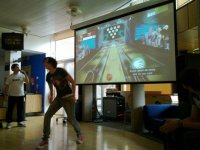Kinect in the Classroom
One of the most interesting ways game-based learning (GBL) is being implemented is with the use of Microsoft’s Kinect. Kinect specifically is an accessory to the Xbox 360, where motion and gestures control game functions. From sports games, to “hack and slash,” the Kinect physically involves the player in gameplay. But why use it in the classroom? And how should you use it in the classroom? Today I present not only a great rationale for use the Kinect in the classroom, but also some specific ideas and resources for doing so.
Brain-Based Learning
As articulated in Edutopia’s “Six Tips for Brain Based Learning,” using active, physical modalities can help the learning process. John Medina author of Brain Rules shows how exercise boosts oxygen-rich blood flow to the brain, which helps students concentrate better. In fact, many schools and classrooms are integrating more physical activity into the school, not just your regular P.E. class. Naperville Central High, for example, uses “brain breaks.”
Instead of having the physical activity as a break from learning to engage in later learning, the Kinect can use the best of both worlds, coupling brain-based physical learning and gestures with learning of content. In addition, we know that games engage us and motivate us to play, provide needed feedback, and provide a safe space to fail. These are all principles of brain-based learning!
Building Lessons
When building a lesson to use the Kinect, make sure you know the instructional purpose of using the Kinect. If you intend to use it as part of the lesson, why are you using it as opposed to something else? Is it used as guided practice? A formative assessment? An extension activity? A piece to differentiate? These are all good purposes, and you might use one or more of them in the lesson planning.
Another important consideration is what game to use. This also relates to cost. Kinect Adventures comes with the purchase of the Kinect itself, but you may have to purchase other games. If cost is a concern, there are many ways to mitigate this issue. I’m a big fan of Donors Choose, and I’ve been successfully funded through them. Just make sure you indicate specific objectives and clear plan. Also, Microsoft offers discounts on the Kinect, and includes a great chart that can help you make decisions for buying.
Resources
There are a great many resources to find not only lessons that use Kinect in the classroom, but also apps that can support more specific learning. One example is Kinect Math - A Kinesthetic Learning Experience that allows teachers to make abstract mathematical concepts more interactive through using the Kinect. Students can manipulate graphs, variables, and more.
In addition, Microsoft has a huge library of classroom lessons, many of which are aligned to the Common Core standards, as well as other learning objectives in physical education and science. The lessons include step by step instructions, grade level and the game that must be used with the game.
There is a great opportunity to use the Kinect in the classroom to not only meet specific learning goals, but engage in research-based practices for learning. Consider developing your own lesson and submitting it to an open-source database of GBL lessons. Let’s work together as a GBL community to uses games effectively in the classroom.
